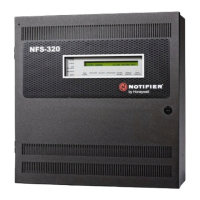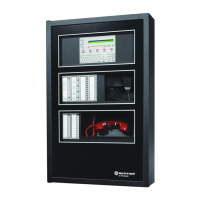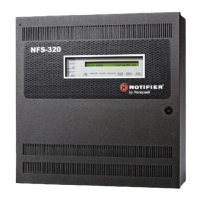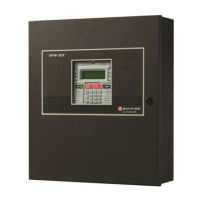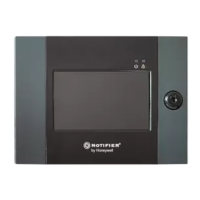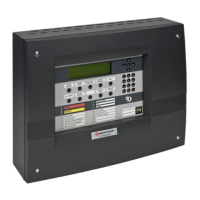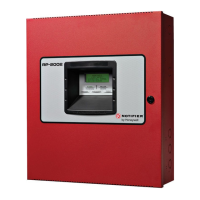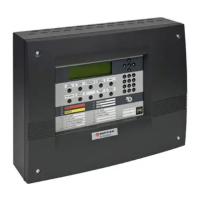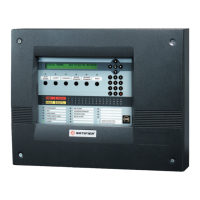32 NFS2-640 UL Listing Document — P/N 52741LD:H9 5/19/2022
5 Testing/Maintenance
When finished with the original installation and all modifications, conduct a complete operational test on the entire installation to verify compliance with applicable
NFPA standards. Testing should be conducted by a factory-trained fire alarm technician in the presence of a representative of the Authority Having Jurisdiction and the
owner’s representative. Follow procedures outlined in NFPA Standard 72’s section on Inspection, Testing and Maintenance. All test and maintenance instruction codes
and software necessary to provide test and inspection requirements of CAN/ULC-S536, Standard for the Inspection and Testing of Fire Alarm Systems.
Disable or Enable a Point
Type Code Silenceable (Y/N) Device Function
CONTROL Y Supervised NAC
BELL CIRCUIT Y Supervised NAC for notification appliance
STROBE CKT Y Supervised NAC for notification appliance
HORN CIRCUIT Y Supervised NAC for notification appliance
AUDIBLE CKT Y Supervised NAC for notification appliance
SPEAKER N Supervised NAC for speaker circuits
REL END BELL N Supervised NAC
blank label Y Supervised NAC for undefined device
REL CKT ULC N Releasing Circuit, power-limited (Class 2), supervised for opens, shorts and ground faults (always non-
silenceable)
RELEASE CKT N Releasing circuit, non-power-limited, supervised for opens and ground faults
REL AUDIBLE Y NAC, activated upon release
REL CODE BELL Y Supervised NAC (NFS2-640 NAC only)
INSTANT RELE N NAC, short = normal; supervised for open circuits and ground faults. Always non-silenceable and switch-
inhibited.
ALARMS PEND N Output that will activate upon receipt of an alarm condition, and remain in the alarm state until all alarms have
been acknowledged. It is programmed as “switch inhibit”.
CONTROL NAC Y Supervised NAC
GEN ALARM N Control Module, an XPC-8 circuit, or an XP5-C (in NAC mode) configured as a Municipal Box Transmitter for
NFPA 72-2002 Auxiliary Fire Alarm Systems applications (MBT-1 required). This Type ID can also be used for
general alarm activation. It is programmed as “switch inhibit”.
GEN SUPERVIS N
Control Module, an XPR-8 relay, or an XP5-C (in relay mode) activated under any Supervisory condition (includes sprinkler
type). It is programmed as “switch inhibit”.
GEN TROUBLE N
Control Module, an XPR-8 relay, or an XP5-C (in relay mode) activated under any System Trouble condition. It is programmed
as “switch inhibit”.
GENERAL PEND N
Control Module, an XPC-8 circuit, or an XP5-C (in NAC mode) that will activate upon receipt of an alarm and/or trouble
condition, and remain in the ON state until all events have been ACKNOWLEDGED.
TROUBLE PEND N
Control Module, an XPC-8 circuit, or an XP5-C (in NAC mode) that will activate upon receipt of a trouble condition, and remain
in the ON state until all troubles have been ACKNOWLEDGED. It is programmed as “switch inhibit”.
Table 10 NAC Type Codes
NOTE: Use 0 (zero) ohm impedance when testing wire-to-wire faults.
WARNING: DO NOT USE SOFTWARE FOR RELEASING LOCKOUT
DO NOT RELY ON DISABLE/ENABLE SOFTWARE SETTINGS TO LOCK OUT RELEASING DEVICES. RELEASING DEVICES
MUST BE PHYSICALLY DISCONNECTED.
NOTE: When an input or output point associated with releasing functions is disabled, a single supervisory trouble will be generated.
The address of a NAC connected
through NAC 1 (B01), NAC 2
(B02), NAC 3 (B03), or NAC 4
(B04)
Five zones for CBE list; the default zone
selection is 00 (general alarm)
Default zone
12 spaces for extended
custom label
Switch Inhibit: I=selected; *=off (default)
Walk Test Selection: *=off (default);
W=selected
Silenceable: O=selected; *=off (default)
Type Code
20-character user-editable custom label
PROGRAM CONTROL Notification Dev No1
00 __ __ __ __ *OW B01

